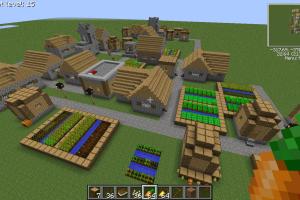Ultimate Guide to Building a Thriving Minecraft Village

-
Quick Links:
- Introduction
- Understanding Minecraft Villages
- Planning Your Village
- Choosing the Right Location
- Building the Infrastructure
- Designing Your Village
- Bringing Inhabitants
- Maintaining Your Village
- Case Studies and Examples
- Expert Insights
- FAQs
Introduction
Minecraft is a world of creativity and imagination, where players can build anything they desire. One popular project among players is creating a village, which can serve as a home base, a trading hub, or simply a fun place to explore. In this guide, we'll delve into the step-by-step process of building a Minecraft village from scratch, ensuring that it thrives with inhabitants and resources.
Understanding Minecraft Villages
Minecraft villages are naturally occurring structures that contain villagers, farms, and other features. Understanding the mechanics of these villages is crucial for creating your own. Villagers can perform various roles, such as farmers, blacksmiths, and librarians, each contributing to the village's economy.
Types of Villagers
- Farmer: Grows crops and can trade food.
- Blacksmith: Offers tools and armor.
- Librarian: Trades books and enchanted items.
- Cleric: Trades for potions and experience.
Planning Your Village
Planning is essential before starting to build your village. Consider the following factors:
- Purpose of the village (trading, storage, etc.).
- Size and layout (how many buildings, streets, etc.).
- Resources available in the area.
Choosing the Right Location
The location of your village greatly affects its success. Look for a flat area with access to resources such as wood, stone, water, and food sources. Biomes like plains or savannas can provide ample space for expansion.
Building the Infrastructure
Once you've chosen a location, it’s time to lay down the infrastructure. This includes:
Roads and Pathways
Creating pathways between buildings improves navigation and aesthetics. Use materials like cobblestone or gravel for a rustic look.
Housing
Build houses for villagers that have enough space for them to move and work. Each house should have:
- A bed
- A workstation (e.g., a composter for farmers)
- Access to food and water
Designing Your Village
Design plays a key role in making your village inviting and functional. Consider the following design elements:
Architecture Styles
Choose an architectural style that fits the theme of your village, whether it's medieval, modern, or rustic.
Community Spaces
Design spaces where villagers can gather, such as:
- Marketplaces
- Parks
- Gathering halls
Bringing Inhabitants
Once your village is built, you’ll need to attract villagers. You can do this by:
- Transporting villagers from nearby villages using boats or minecarts.
- Creating beds and workstations to encourage villagers to spawn.
Maintaining Your Village
To ensure your village remains vibrant, you need to keep an eye on various factors:
- Protection from mobs by building walls or lighting up the area.
- Regularly trading with villagers to enhance their professions.
- Expanding the village as you gather more resources.
Case Studies and Examples
Here are some examples of successful Minecraft villages that showcase creativity and functionality:
Example 1: The Coastal Village
A village built on a beach, featuring fishing docks and harbor-style homes. This design maximizes water access and provides a unique aesthetic.
Example 2: The Mountain Village
Built into the side of a mountain, this village uses vertical space effectively and creates stunning views. It includes terraces for farming.
Expert Insights
According to Minecraft community experts, successful villages often incorporate a mix of aesthetics and functionality. Here are some key tips:
- Use a variety of building materials to enhance visual appeal.
- Encourage villager breeding by providing enough beds and food.
- Regularly update the village layout to adapt to gameplay changes.
FAQs
1. How do I attract villagers to my Minecraft village?
You can attract villagers by creating beds and workstations or transporting them from nearby villages.
2. What is the best biome for building a Minecraft village?
Plains and savanna biomes are great choices due to their flat terrain and resource availability.
3. How can I protect my village from mobs?
Build walls around the village and use torches to light up the area, preventing hostile mobs from spawning.
4. Can villagers breed in Minecraft?
Yes, villagers can breed if there are enough beds and food available in the village.
5. What are the benefits of building a village in Minecraft?
Villages provide trading opportunities, sources of food, and a safe haven from hostile mobs.
6. How do I increase the number of villagers in my village?
Encouraging breeding by ensuring there are enough beds and food will increase your villager population.
7. Can I customize villagers’ professions?
Yes, villagers can change professions based on the workstation they interact with. Destroying their current workstation will reset their profession.
8. What materials are best for building village houses?
Wood, stone, and cobblestone are popular choices due to their availability and ease of crafting.
9. How do I make sure my village is thriving?
Regularly trade with villagers, expand their living space, and protect them from threats to ensure a thriving village.
10. Can I use mods to enhance my village-building experience?
Yes, many mods can add new features and options for building and managing your village, enhancing the overall experience.
Conclusion
Building a Minecraft village is a rewarding experience that allows for endless creativity and interaction. By following the steps outlined in this guide, you can create a thriving community that will stand the test of time in your Minecraft world. Happy building!